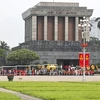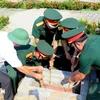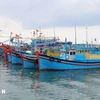HCM City (VNA) - Local and international experts have proposed solutions to help HCM City secure its short- and long-term water supply.
The solutions were discussed on April 8 after a four-day brainstorming workshop organised by the Saigon Water Corporation and the Dutch-funded project "Climate Change and Water Supply in the Mekong Delta and HCM City”.
Experts proposed building multiple day reservoirs that hold river water to supply water to the city when the salinity rate is high, and a long pipeline from the Dau Tieng Reservoir carrying water to water treatment plants, among other solutions.
They also suggested using the 19-km existing river bed of Lang The in HCM City’s Cu Chi District while moving the intake station upstream, and building a salinity weir.
They said the city should take immediate action at Hoa Phu intake station, including adjusting the raw water intake criteria for chloride and mixture with water at the Kenh Dong Water Treatment Plant.
Forecasting salinity levels on the two rivers, combined with an improved flushing policy for the Dau Tieng Reservoir, were two other solutions suggested.
In 2012, Sawaco outlined a plan for securing water supply in the city through several measures, including reforestation, construction of sea barrier in estuary of Nha Be River, and control of industrial zone development upstream and downstream of intakes.
The company also had plans to ask Tri An and Dau Tieng authorities to flush Dong Nai and Saigon rivers. The plan to relocate water intakes to the two reservoirs was also mentioned.
Beside the plan to apply new treatment technologies, building raw water storage reservoirs was also considered.
Rik Dierx, resident project manager of the Dutch-funded project "Climate Change and Water Supply in the Mekong Delta and HCM City", said that experts were not privileged to spend the money, but they could give suggestions for short- and long-term solutions that could help solve the problem.
The Dutch expert said that, based on a recent survey of the saline rate on the Saigon River, this level of high salinity had never previously occurred. This has put Sawaco in a difficult situation in finding solutions.
It is possible that Sawaco would have to stop supplying water for a half day or a full day in the future when there is high saline intrusion, if the company does not adapt to the situation.
In the worst case scenario, Rik suggested the company continue supplying water with a saline rate higher than the permitted level, because when the supply stops, dirty water will get into the pipe system, affecting the equipment.
“So far, there is no problem, but we have to be prepared,” he said, adding that he cannot predict how many years from now Sawaco will periodically pause supplying water, especially with the increasing saline-rate situation.
He said there was a threat that some day the Dau Tieng Reservoir, which is used to release water to desalinate the Saigon River, would not have enough water for this function.
With the proposed solutions made at the workshop, Sawaco will evaluate and make suggestions to the city government for investment.
The current severe drought and rise in sea levels has caused saline intrusion in the Saigon and Dong Nai rivers.
The two rivers supply raw water to businesses and more than 10 million residents.
Since early this year, there has been a shortage of raw water due to the high salinity level, which has been over 250mg per litre, said Tran Cuong of the Saigon Water Corporation.
The company’s water treatment plants had to shut down between four and five hours during the period of high saline rate, Cuong said, adding that the saline rate in the water of the Saigon River was recorded at nearly 600mg per litre at the Hoa Phu Intake on March 31.
A few weeks before that, the saline rate in the Saigon River was 400mg per litre, but the maximum-permitted salinity rate is 250mg per litre, according to Sawaco’s report.-VNA

























